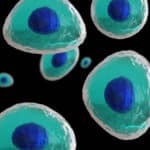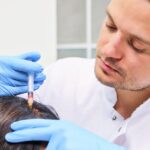Modern aesthetic medicine increasingly relies on advanced biological solutions that support the body’s natural regenerative processes. One of the most promising directions in hair loss therapy is exosomes – microscopic extracellular vesicles that contain proteins, lipids, growth factors, and genetic material. Thanks to their regenerative properties, exosomes are gaining popularity in therapies aimed at rebuilding hair follicles and improving hair quality and density.
What are exosomes and why are they so popular?
Exosomes are secreted by cells, and their main function is intercellular communication. They can be considered the body’s natural “communication system” – transporting signals that activate target cells for regeneration, multiplication, or activity changes. In the context of scalp and hair therapy, exosomes most often come from mesenchymal stem cells, which have strong anti-inflammatory, growth-promoting, and tissue-regenerating properties.
“Exosomes are one of the most promising methods of scalp regeneration – their action not only stimulates hair follicles but also creates the perfect environment for new hair growth.”
– Dr Piotr Turkowski
Exosomes act directly on scalp cells as well as dermal papilla cells – the structures responsible for hair growth and the hair life cycle. By delivering “instructions” contained in proteins and microRNA, exosomes can restore the function of damaged or dormant follicles.
Exosome therapy for hair at PT Clinic in Warsaw
Exosomes and the hair life cycle – how do they affect follicles?
Hair growth follows a cycle consisting of three main phases: anagen (growth), catagen (regression), and telogen (rest). In many cases of alopecia – both androgenetic and telogen – the problem is a shortened anagen phase and prolonged follicle dormancy. Exosomes can reverse this process, bringing follicles back into the active growth phase.

Thanks to their content of growth factors (including VEGF, FGF, IGF), exosomes stimulate angiogenesis – the formation of new blood vessels, improving scalp blood flow and nutrient supply to hair follicles. At the same time, they act anti-inflammatory, which is particularly important in cases where hair loss is caused by inflammatory processes in the scalp.
What does exosome treatment look like?
Exosome therapy is performed on an outpatient basis and resembles scalp mesotherapy. The exosome preparation is injected directly into the scalp using a fine needle, allowing precise delivery to the perfollicular area. The treatment is generally well tolerated – it may cause only mild redness or short-term skin tightness.
Depending on individual needs, baseline scalp condition, and type of alopecia, the therapy may require several sessions performed at intervals of a few weeks. Already after the first treatments, many patients notice an improvement in scalp condition, reduced shedding, and the appearance of baby hair – new, fine hairs in thinning areas.
Exosomes and hair transplants – supportive therapy
At Piotr Turkowski’s Clinic, exosome therapy is used not only as a standalone treatment but also as a complement to hair transplantation with the FUE method. Thanks to their regenerative properties, exosomes accelerate healing after transplantation and support the growth of transplanted follicles. Introducing them in the perioperative period also improves the overall scalp microenvironment, increasing the chances of achieving dense, natural results.
Importantly, exosomes not only support new grafts but can also stimulate weakened follicles that have not been completely destroyed. Combined with proper trichological diagnostics and pharmacological therapy, exosomes form a key element of modern approaches to hair loss treatment.
The future of alopecia treatment – exosomes as an alternative to stem cells?
Although stem cells remain an important part of regenerative medicine, exosomes are becoming a real alternative – for several key reasons. First of all, their use does not require collecting biological material from the patient, and the therapy carries no risk of rejection or immune reactions. Exosomes are also easier to standardize, which makes their use more predictable and safer.
Exosome therapies are constantly evolving – increasingly specialized preparations are being developed, tailored to specific types of alopecia and individual patient needs. Combined with growing patient awareness and the availability of modern technological solutions, exosomes have the potential to revolutionize the approach to treating scalp and follicle disorders.
At Piotr Turkowski’s Clinic, we approach each patient individually. We warmly invite you to contact us to discover all the benefits and possibilities exosomes offer in hair follicle regeneration.







